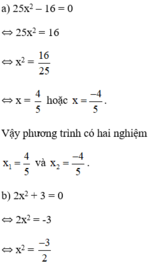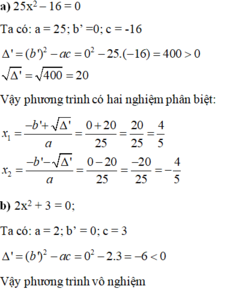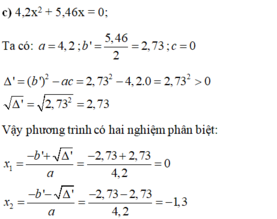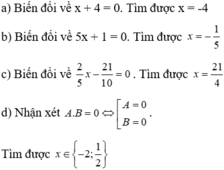Giải các phương trình: 16 x - 3 + 30 1 - x = 3
Hãy nhập câu hỏi của bạn vào đây, nếu là tài khoản VIP, bạn sẽ được ưu tiên trả lời.


\(a,\dfrac{x-3}{x}=\dfrac{x-3}{x+3}\)\(\left(đk:x\ne0,-3\right)\)
\(\Leftrightarrow\dfrac{x-3}{x}-\dfrac{x-3}{x+3}=0\)
\(\Leftrightarrow\dfrac{\left(x-3\right)\left(x+3\right)-x\left(x-3\right)}{x\left(x+3\right)}=0\)
\(\Leftrightarrow x^2-9-x^2+3x=0\)
\(\Leftrightarrow3x-9=0\)
\(\Leftrightarrow3x=9\)
\(\Leftrightarrow x=3\left(n\right)\)
Vậy \(S=\left\{3\right\}\)
\(b,\dfrac{4x-3}{4}>\dfrac{3x-5}{3}-\dfrac{2x-7}{12}\)
\(\Leftrightarrow\dfrac{4x-3}{4}-\dfrac{3x-5}{3}+\dfrac{2x-7}{12}>0\)
\(\Leftrightarrow\dfrac{3\left(4x-3\right)-4\left(3x-5\right)+2x-7}{12}>0\)
\(\Leftrightarrow12x-9-12x+20+2x-7>0\)
\(\Leftrightarrow2x+4>0\)
\(\Leftrightarrow2x>-4\)
\(\Leftrightarrow x>-2\)

1/ \(x^3-7x+6=0\)
\(\Leftrightarrow x^3+3x^2-3x^2-9x+2x+6=0\)
\(\Leftrightarrow x^2\left(x+3\right)-3x\left(x+3\right)+2\left(x+3\right)=0\)
\(\Leftrightarrow\left(x+3\right)\left(x^2-3x+2\right)=0\)
\(\Leftrightarrow\left(x+3\right)\left(x^2-x-2x+2\right)=0\)
\(\Leftrightarrow\left(x+3\right)\left[x\left(x-1\right)+2\left(x-1\right)\right]=0\)
\(\Leftrightarrow\left(x+3\right)\left(x-1\right)\left(x+2\right)=0\)
\(\Leftrightarrow\)\(x+3=0\)
hoặc \(x-1=0\)
hoặc \(x+2=0\)
\(\Leftrightarrow\)\(x=-3\)
hoặc \(x=1\)
hoặc \(x=-2\)
Vậy tập nghiệm của phương trình là : \(S=\left\{-3;1;-2\right\}\)
2/ \(x^3-6x^2-x+30\)
\(\Leftrightarrow x^3+2x^2-8x^2-16x+15x+30=0\)
\(\Leftrightarrow x^2\left(x+2\right)-8x\left(x+2\right)+15\left(x+2\right)=0\)
\(\Leftrightarrow\left(x+2\right)\left(x^2-8x+15\right)=0\)
\(\Leftrightarrow\left(x+2\right)\left(x^2-3x-5x+15\right)=0\)
\(\Leftrightarrow\left(x+2\right)\left[x\left(x-3\right)-5\left(x-3\right)\right]=0\)
\(\Leftrightarrow\left(x+2\right)\left(x-3\right)\left(x-5\right)=0\)
\(\Leftrightarrow\)\(x+2=0\)
hoặc \(x-3=0\)
hoặc \(x-5=0\)
\(\Leftrightarrow\)\(x=-2\)
hoặc \(x=3\)
hoặc \(x=5\)
Vậy tập nghiệm của phương trình là :\(S=\left\{-2;3;5\right\}\)
3/ \(x^3-9x^2+6x+16=0\)
\(\Leftrightarrow x^3+x^2-10x^2-10x+16x+16=0\)
\(\Leftrightarrow x^2\left(x+1\right)-10x\left(x+1\right)+16\left(x+1\right)=0\)
\(\Leftrightarrow\left(x+1\right)\left(x^2-10x+16\right)=0\)
\(\Leftrightarrow\left(x+1\right)\left(x^2-8x-2x+16\right)=0\)
\(\Leftrightarrow\left(x+1\right)\left[x\left(x-8\right)-2\left(x-8\right)\right]=0\)
\(\Leftrightarrow\left(x+1\right)\left(x-8\right)\left(x-2\right)=0\)
\(\Leftrightarrow\)\(x+1=0\)
hoặc \(x-8=0\)
hoặc \(x-2=0\)
\(\Leftrightarrow\)\(x=-1\)
hoặc \(x=8\)
hoặc \(x=2\)
Vậy tập nghiệm của phương trình là :\(S=\left\{-1;8;2\right\}\)
4/ Đề bài sai ! Sửa lại nhé :
\(2x^3-x^2+5x+3=0\)
\(\Leftrightarrow2x^3+x^2-2x^2-x+6x+3=0\)
\(\Leftrightarrow x^2\left(2x+1\right)-x\left(2x+1\right)+3\left(2x-1\right)=0\)
\(\Leftrightarrow\left(2x+1\right)\left(x^2-x+3\right)=0\)
\(\Leftrightarrow\orbr{\begin{cases}2x+1=0\\x^2-x+3=0\end{cases}}\)
\(\Leftrightarrow\orbr{\begin{cases}x=-\frac{1}{2}\left(tm\right)\\\left(x-\frac{1}{2}\right)^2+\frac{11}{4}=0\left(ktm\right)\end{cases}}\)
Vậy tập nghiệm của phương trình là : \(S=\left\{-\frac{1}{2}\right\}\)

a) \(\dfrac{2}{x-3}+\dfrac{x-5}{x-1}=1\)
\(\Leftrightarrow\dfrac{2\left(x-1\right)+\left(x-5\right)\left(x-3\right)}{\left(x-3\right)\left(x-1\right)}=1\)
\(\Leftrightarrow2\left(x-1\right)+\left(x-5\right)\left(x-3\right)=\left(x-3\right)\left(x-1\right)\)
\(\Leftrightarrow2x-2+x^2-8x+15-x^2+4x-3=0\)
\(\Leftrightarrow-2x+10=0\) \(\Leftrightarrow x=5\)
b) \(\dfrac{x+1}{x-1}-\dfrac{x-1}{x+1}=\dfrac{16}{x^2-1}\) (2)
Ta có \(x^2-1=\left(x-1\right)\left(x+1\right)\)
ĐKXĐ: \(x^2-1\ne0\Leftrightarrow x\ne\pm1\)
(2) \(\Leftrightarrow\dfrac{\left(x+1\right)^2-\left(x-1\right)^2-16}{x^2-1}=0\)
mà \(x^2-1\ne0\) để phương trính có nghĩa
\(\Leftrightarrow\left(x+1\right)^2=\left(x-1\right)^2-16=0\)
\(\Leftrightarrow x^2+2x+1-x^2+2x-1-16=0\)
\(\Leftrightarrow4x-16=0\) \(\Leftrightarrow x=4\)

a) \(x^2-4x+4=25\\ \Rightarrow\left(x-2\right)^2=25\\ \Rightarrow\left[{}\begin{matrix}x-2=-5\\x-2=5\end{matrix}\right.\\ \Rightarrow\left[{}\begin{matrix}x=-3\\x=7\end{matrix}\right.\)
b) \(\left(5-2x\right)^2-16=0\\ \Rightarrow\left(5-2x\right)^2=16\\ \Rightarrow\left[{}\begin{matrix}5-2x=-4\\5-2x=4\end{matrix}\right.\\ \Rightarrow\left[{}\begin{matrix}x=4,5\\0,5\end{matrix}\right.\)
c) \(\left(x-3\right)^3-\left(x-3\right)\left(x^2+3x+9\right)+9\left(x+1\right)^2=15\\ \Rightarrow\left(x-3\right)^3-\left(x-3\right)^3+9\left(x+1\right)^2=15\\ \Rightarrow9\left(x+1\right)^2=15\\ \Rightarrow\left(x+1\right)^2=\dfrac{5}{3}\\ \Rightarrow\left[{}\begin{matrix}x+1=-\sqrt{\dfrac{5}{3}}\\x+1=\sqrt{\dfrac{5}{3}}\end{matrix}\right.\)
\(\Rightarrow\left[{}\begin{matrix}x=-\dfrac{3+\sqrt{15}}{3}\\x=\dfrac{-3+\sqrt{15}}{3}\end{matrix}\right.\)
a)\(\Leftrightarrow\)\(x^2-4x-21=0\)
\(\Leftrightarrow\)\(x^2-7x+3x-21=0\)
\(\Leftrightarrow\)\(x(x-7)+3(x-7)=0\)
\(\Leftrightarrow\)\((x-7)(x+3)=0\)
\(\Leftrightarrow\)\(\left[\begin{array}{} x=7\\ x=-3 \end{array} \right.\)
b)\(\Leftrightarrow\)\((5-2x)^2-4^2=0\)
\(\Leftrightarrow\)\((5-2x-4)(5-2x+4)=0\)
\(\Leftrightarrow\)\((-2x+1)(-2x+9)=0\)
\(\Leftrightarrow\)\(\left[\begin{array}{} x=\dfrac{1}{2}\\ x=\dfrac{9}{2} \end{array} \right.\)


Phương trình vô nghiệm vì x 2 ≥ 0 với mọi x.
c) 4 , 2 x 2 + 5 , 46 x = 0
⇔ x.(4,2x + 5,46) = 0
⇔ x = 0 hoặc 4,2x + 5,46 = 0
+Nếu 4,2x + 5,46 = 0 ⇔ 
Vậy phương trình có hai nghiệm
x
1
=
0
và 
d) 4 x 2 - 2 √ 3 x = 1 - √ 3 . ⇔ 4 x 2 - 2 √ 3 x – 1 + √ 3 = 0
Có a = 4; b’ = -√3; c = -1 + √3;
Δ ’ = b ' 2 – a c = ( - √ 3 ) 2 – 4 ( - 1 + √ 3 ) = 7 - 4 √ 3 = 4 – 2 . 2 . √ 3 + ( √ 3 ) 2 = ( 2 - √ 3 ) 2 .
Phương trình có hai nghiệm phân biệt:

Cách 2: Sử dụng công thức nghiệm thu gọn với a, b, c


Kiến thức áp dụng
Phương trình ax2 + bx + c = 0 (a ≠ 0) có biệt thức Δ = b2 – 4ac.
+ Nếu Δ > 0, phương trình có hai nghiệm phân biệt 
+ Nếu Δ = 0, phương trình có nghiệm kép  ;
;
+ Nếu Δ < 0, phương trình vô nghiệm.

Thấy : \(x^2-4x+16=\left(x-2\right)^2+12>0\forall x\)
P/t \(\Leftrightarrow2\left(x^2-4x+16\right)-36+\sqrt{x^2-4x+16}=0\)
Đặt \(t=\sqrt{x^2-4x+16}>0\) ; khi đó :
\(2t^2+t-36=0\) \(\Leftrightarrow\left[{}\begin{matrix}t=4\\t=-\dfrac{9}{2}\left(L\right)\end{matrix}\right.\)
Với t = 4 hay \(\sqrt{x^2-4x+16}=4\Leftrightarrow x^2-4x=0\)
\(\Leftrightarrow\left[{}\begin{matrix}x=0\\x=4\end{matrix}\right.\)
Vậy ...

a) \({3^{x + 2}} = \sqrt[3]{9} \Leftrightarrow {3^{x + 2}} = {9^{\frac{1}{3}}} \Leftrightarrow {3^{x + 2}} = {\left( {{3^2}} \right)^{\frac{1}{3}}} \Leftrightarrow {3^{x + 2}} = {3^{\frac{2}{3}}} \Leftrightarrow x + 2 = \frac{2}{3} \Leftrightarrow x = - \frac{4}{3}\)
b) \({2.10^{2{\rm{x}}}} = 30 \Leftrightarrow {10^{2{\rm{x}}}} = 15 \Leftrightarrow 2{\rm{x}} = \log 15 \Leftrightarrow x = \frac{1}{2}\log 15\)
c) \({4^{2{\rm{x}}}} = {8^{2{\rm{x}} - 1}} \Leftrightarrow {\left( {{2^2}} \right)^{2{\rm{x}}}} = {\left( {{2^3}} \right)^{2{\rm{x}} - 1}} \Leftrightarrow {2^{4{\rm{x}}}} = {2^{6{\rm{x}} - 3}} \Leftrightarrow 4{\rm{x}} = 6{\rm{x}} - 3 \Leftrightarrow - 2{\rm{x}} = - 3 \Leftrightarrow x = \frac{3}{2}\).

Điều kiện : x ≠ 3 và x ≠ 1
Ta có: 16 x - 3 + 30 1 - x = 3 ⇔ 16(1 – x) +30(x -3) =3(x -3)(1 –x)
⇔ 16 – 16x +30x -90 =3x -3 x 2 -9 +9x
⇔ 3 x 2 +2x -65 =0
∆ ’ = 1 2 -3.(-65) = 1 + 195=196 > 0
∆ ' = 196 =14
Giá trị của x thỏa mãn điều kiện bài toán
Vậy nghiệm của phương trình là x =13/3 và x =-5